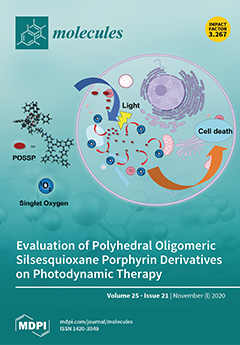Epidermal growth factor receptor (EGFR) and cyclooxygenase-2 (COX-2) are crucial targetable enzymes in cancer management. Therefore, herein, new 2-[(5-((1
H-indol-3-yl)methyl)-1,3,4-oxadiazol-2-yl)thio]-
N-(thiazol/benzothiazol-2-yl)acetamides (
2a–i) were designed and synthesized as EGFR and COX-2 inhibitors. The cytotoxic effects of compounds
2a–
i
[...] Read more.
Epidermal growth factor receptor (EGFR) and cyclooxygenase-2 (COX-2) are crucial targetable enzymes in cancer management. Therefore, herein, new 2-[(5-((1
H-indol-3-yl)methyl)-1,3,4-oxadiazol-2-yl)thio]-
N-(thiazol/benzothiazol-2-yl)acetamides (
2a–i) were designed and synthesized as EGFR and COX-2 inhibitors. The cytotoxic effects of compounds
2a–
i on HCT116 human colorectal carcinoma, A549 human lung adenocarcinoma, and A375 human melanoma cell lines were determined using MTT assay. 2-[(5-((1
H-Indol-3-yl)methyl)-1,3,4-oxadiazol-2-yl)thio]-
N-(6-ethoxybenzothiazol-2-yl)acetamide (
2e) exhibited the most significant anticancer activity against HCT116, A549, and A375 cell lines with IC
50 values of 6.43 ± 0.72 μM, 9.62 ± 1.14 μM, and 8.07 ± 1.36 μM, respectively, when compared with erlotinib (IC
50 = 17.86 ± 3.22 μM, 19.41 ± 2.38 μM, and 23.81 ± 4.17 μM, respectively). Further mechanistic assays demonstrated that compound
2e enhanced apoptosis (28.35%) in HCT116 cells more significantly than erlotinib (7.42%) and caused notable EGFR inhibition with an IC
50 value of 2.80 ± 0.52 μM when compared with erlotinib (IC
50 = 0.04 ± 0.01 μM). However, compound
2e did not cause any significant COX-2 inhibition, indicating that this compound showed COX-independent anticancer activity. The molecular docking study of compound
2e emphasized that the benzothiazole ring of this compound occupied the allosteric pocket in the EGFR active site. In conclusion, compound
2e is a promising EGFR inhibitor that warrants further clinical investigations.
Full article






